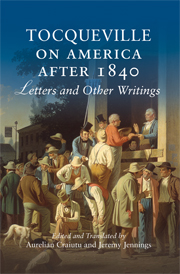Book contents
- Frontmatter
- Contents
- Editors' Note and Acknowledgments
- Interpretative Essay: The Third Democracy: Tocqueville's Views of America after 1840
- PART I LETTERS
- PART II SPEECHES, ARTICLES, AND DIPLOMATIC PAPERS
- General Introduction
- A America in the 1840s
- B America and the Revolution of 1848
- C Tocqueville's Contributions to the Debates on the Constitution of the Second Republic
- D The Poussin Affair
- E Final Thoughts on the American Constitution
- Appendix 1 Tocqueville's American Correspondents
- Appendix 2 Chronology
- Appendix 3 Sources for the Texts and Selected Bibliography
- Notes
- Index
B - America and the Revolution of 1848
Published online by Cambridge University Press: 05 June 2012
- Frontmatter
- Contents
- Editors' Note and Acknowledgments
- Interpretative Essay: The Third Democracy: Tocqueville's Views of America after 1840
- PART I LETTERS
- PART II SPEECHES, ARTICLES, AND DIPLOMATIC PAPERS
- General Introduction
- A America in the 1840s
- B America and the Revolution of 1848
- C Tocqueville's Contributions to the Debates on the Constitution of the Second Republic
- D The Poussin Affair
- E Final Thoughts on the American Constitution
- Appendix 1 Tocqueville's American Correspondents
- Appendix 2 Chronology
- Appendix 3 Sources for the Texts and Selected Bibliography
- Notes
- Index
Summary
Introduction
The protests that erupted in February 1848, leading to the hasty abdication of King Louis-Philippe and the birth of the Second Republic, found republicans in France not only weak but also divided, both ideologically and organizationally. It was to these individuals, however, that (quite unexpectedly) was to fall the task of steering France toward yet another constitution. Now, for the first time republicans saw the opportunity of establishing a Republic which would embody not just the political equality of the ballot box but also the social and economic demands they had campaigned for over the previous decades. These views were no better expressed than by the socialist Louis Blanc. Liberty, on his view, was seen not just as a “right” but as the “ability” to exercise our faculties to the full. If Blanc recognized the importance of those liberties which he himself listed as liberty of the press, of conscience, and of association, he believed that the socialist conception of liberty had to be pushed much further, so as to embrace a range of liberties which would abolish the servitude which arose from poverty and hunger. By liberty, then, was meant not just the narrow conception of the absence of restraint, but something which was tied to a different vision of society: the social Republic.
If Tocqueville, somewhat reluctantly, rallied to the Second Republic, he was equally determined that it should not be pushed in a radical direction and that the republicans should not be allowed to relive the revolutionary fantasies of the past.
- Type
- Chapter
- Information
- Tocqueville on America after 1840Letters and Other Writings, pp. 370 - 376Publisher: Cambridge University PressPrint publication year: 2009



